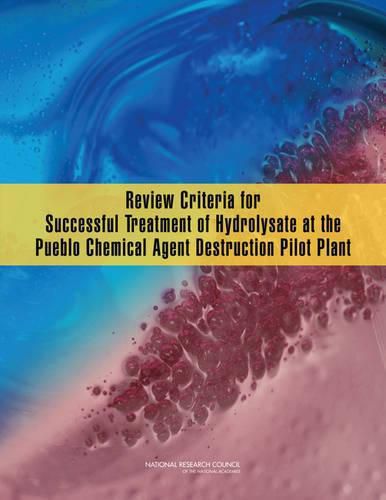Readings Newsletter
Become a Readings Member to make your shopping experience even easier.
Sign in or sign up for free!
You’re not far away from qualifying for FREE standard shipping within Australia
You’ve qualified for FREE standard shipping within Australia
The cart is loading…






One of the last two sites with chemical munitions and chemical materiel is the Pueblo Chemical Depot in Pueblo, Colorado. The stockpile at this location consists of about 800,000 projectiles and mortars, all of which are filled with the chemical agent mustard. Under the direction of the Assembled Chemical Weapons Alternative Program (ACWA), the Army has constructed the Pueblo Chemical Agent Destruction Pilot Plant (PCAPP) to destroy these munitions. The primary technology to be used to destroy the mustard agent at PCAPP is hydrolysis, resulting in a secondary waste stream referred to as hydrolysate.
PCAPP features a process that will be used to treat the hydrolysate and the thiodiglycol - a breakdown product of mustard - contained within. The process is a biotreatment technology that uses what are known as immobilized cell bioreactors. After biodegradation, the effluent flows to a brine reduction system, producing a solidified filter cake that is intended to be sent offsite to a permitted hazardous waste disposal facility. Water recovered from the brine reduction system is intended to be recycled back through the plant, thereby reducing the amount of water that is withdrawn from groundwater. Although biotreatment of toxic chemicals, brine reduction, and water recovery are established technologies, never before have these technologies been combined to treat mustard hydrolysate.
At the request of the U.S. Army, Review Criteria for Successful Treatment of Hydrolysate at the Pueblo Chemical Agent Destruction Pilot Plant reviews the criteria for successfully treating the hydrolysate. This report provides information on the composition of the hydrolysate and describes the PCAPP processes for treating it; discusses stakeholder concerns; reviews regulatory considerations at the federal, state, and local levels; discusses Department of Transportation regulations and identifies risks associated with the offsite shipment of hydrolysate; establishes criteria for successfully treating the hydrolysate and identifies systemization data that should factor into the criteria and decision process for offsite transport and disposal of the hydrolysate; and discusses failure risks and contingency options as well as the downstream impacts of a decision to ship hydrolysate offsite.
$9.00 standard shipping within Australia
FREE standard shipping within Australia for orders over $100.00
Express & International shipping calculated at checkout
One of the last two sites with chemical munitions and chemical materiel is the Pueblo Chemical Depot in Pueblo, Colorado. The stockpile at this location consists of about 800,000 projectiles and mortars, all of which are filled with the chemical agent mustard. Under the direction of the Assembled Chemical Weapons Alternative Program (ACWA), the Army has constructed the Pueblo Chemical Agent Destruction Pilot Plant (PCAPP) to destroy these munitions. The primary technology to be used to destroy the mustard agent at PCAPP is hydrolysis, resulting in a secondary waste stream referred to as hydrolysate.
PCAPP features a process that will be used to treat the hydrolysate and the thiodiglycol - a breakdown product of mustard - contained within. The process is a biotreatment technology that uses what are known as immobilized cell bioreactors. After biodegradation, the effluent flows to a brine reduction system, producing a solidified filter cake that is intended to be sent offsite to a permitted hazardous waste disposal facility. Water recovered from the brine reduction system is intended to be recycled back through the plant, thereby reducing the amount of water that is withdrawn from groundwater. Although biotreatment of toxic chemicals, brine reduction, and water recovery are established technologies, never before have these technologies been combined to treat mustard hydrolysate.
At the request of the U.S. Army, Review Criteria for Successful Treatment of Hydrolysate at the Pueblo Chemical Agent Destruction Pilot Plant reviews the criteria for successfully treating the hydrolysate. This report provides information on the composition of the hydrolysate and describes the PCAPP processes for treating it; discusses stakeholder concerns; reviews regulatory considerations at the federal, state, and local levels; discusses Department of Transportation regulations and identifies risks associated with the offsite shipment of hydrolysate; establishes criteria for successfully treating the hydrolysate and identifies systemization data that should factor into the criteria and decision process for offsite transport and disposal of the hydrolysate; and discusses failure risks and contingency options as well as the downstream impacts of a decision to ship hydrolysate offsite.